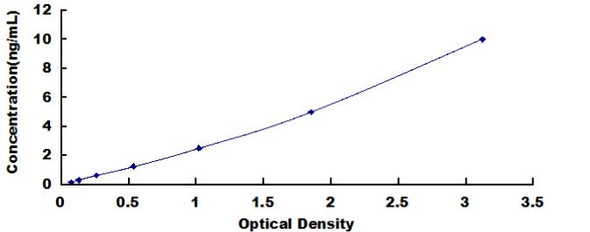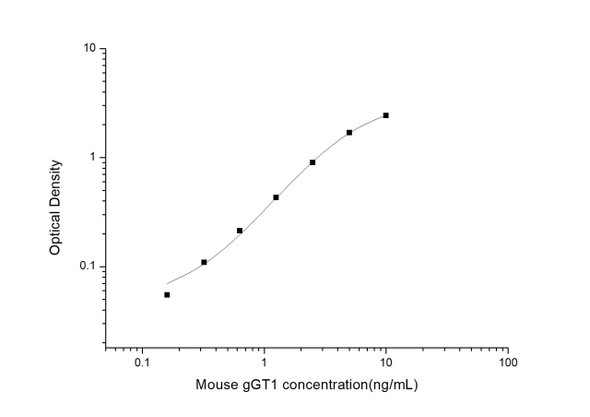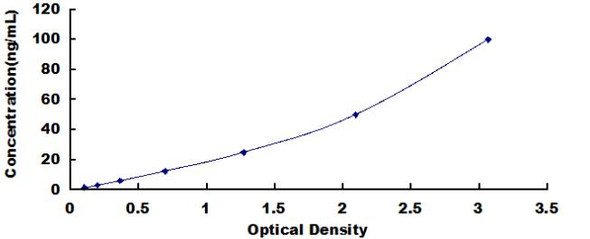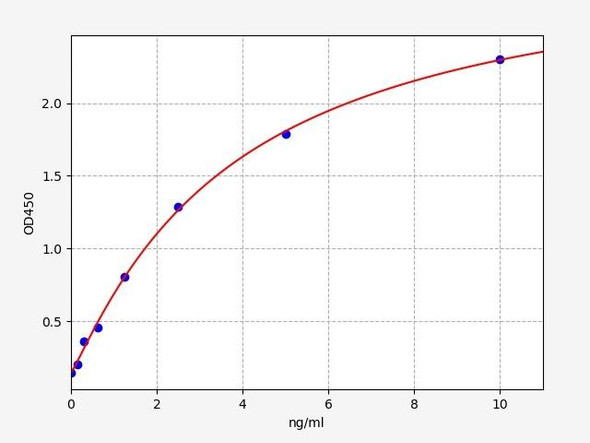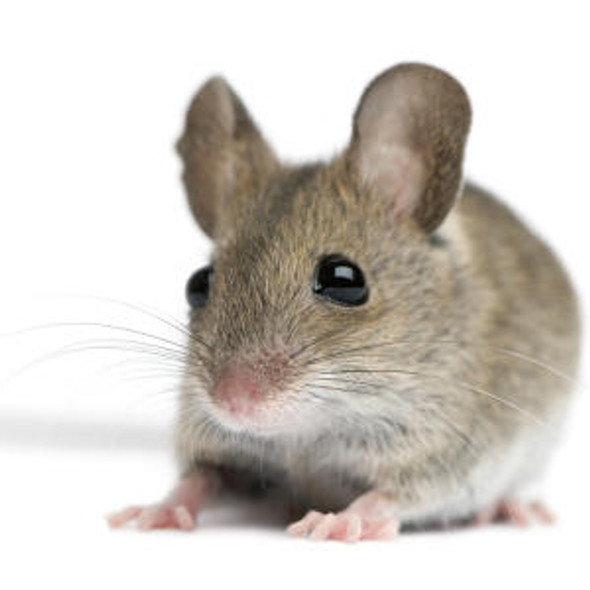Mouse Metabolism ELISA Kits
Mouse gGT1 (Gamma Glutamyltransferase 1) CLIA Kit (MOES00283)
- SKU:
- MOES00283
- Product Type:
- ELISA Kit
- ELISA Type:
- CLIA Kit
- Size:
- 96 Assays
- Sensitivity:
- 18.75pg/mL
- Range:
- 31.25-2000pg/mL
- ELISA Type:
- Sandwich
- Reactivity:
- Mouse
- Sample Type:
- Serum, plasma and other biological fluids
- Research Area:
- Metabolism
Description
| Assay type: | Sandwich |
| Format: | 96T |
| Assay time: | 4.5h |
| Reactivity: | Mouse |
| Detection method: | Chemiluminescence |
| Detection range: | 31.25-2000 pg/mL |
| Sensitivity: | 18.75 pg/mL |
| Sample volume: | 100µL |
| Sample type: | Serum, plasma and other biological fluids |
| Repeatability: | CV < 15% |
| Specificity: | This kit recognizes Mouse gGT1 in samples. No significant cross-reactivity or interference between Mouse gGT1 and analogues was observed. |
This kit uses Sandwich-CLIA as the method. The micro CLIA plate provided in this kit has been pre-coated with an antibody specific to Mouse gGT1. Standards or samples are added to the appropriate micro CLIA plate wells and combined with the specific antibody. Then a biotinylated detection antibody specific for Mouse gGT1 and Avidin-Horseradish Peroxidase (HRP) conjugate are added to each micro plate well successively and incubated. Free components are washed away. The substrate solution is added to each well. Only those wells that contain Mouse gGT1, biotinylated detection antibody and Avidin-HRP conjugate will appear fluorescence. The Relative light unit (RLU) value is measured spectrophotometrically by the Chemiluminescence immunoassay analyzer. The RLU value is positively associated with the concentration of Mouse gGT1. The concentration of Mouse gGT1 in the samples can be calculated by comparing the RLU of the samples to the standard curve.
| UniProt Protein Function: | Cleaves the gamma-glutamyl bond of extracellular glutathione (gamma-Glu-Cys-Gly), glutathione conjugates, and other gamma-glutamyl compounds. The metabolism of glutathione releases free glutamate and the dipeptide cysteinyl-glycine, which is hydrolyzed to cysteine and glycine by dipeptidases. In the presence of high concentrations of dipeptides and some amino acids, can also catalyze a transpeptidation reaction, transferring the gamma-glutamyl moiety to an acceptor amino acid to form a new gamma-glutamyl compound. Initiates extracellular glutathione (GSH) breakdown, provides cells with a local cysteine supply and contributes to maintain intracellular GSH level. It is part of the cell antioxidant defense mechanism. Indirectly regulates multiple aspects of skeletal biology. |
| NCBI Summary: | This gene encodes gamma-glutamyl transpeptidase, a plasmamembrane-associated enzyme that cleaves the peptide bond between gamma-glutamyl and cysteinyl glycine moieties of glutathione. The encoded protein is autocatalytically processed to generate an enzymatically active heterodimer comprised of heavy and light chains. Mice lacking the encoded protein grow slowly, develop cataracts and have elevated levels of glutathione in plasma and urine. Transgenic overexpression of the encoded protein in mice enhances osteoclastic bone resorption. The mutant alleles termed 'Dwarf grey' and 'Dwarf grey Bayer' in mice are associated with deletions in this gene. A gamma-glutamyl transpeptidase paralog is located adjacent to this gene. Alternative splicing results in multiple transcript variants. Additional transcripts using alternate promoters and differing in 5' UTRs have been described. [provided by RefSeq, Apr 2015] |
| UniProt Code: | Q60928 |
| NCBI GenInfo Identifier: | 807201132 |
| NCBI Gene ID: | 14598 |
| NCBI Accession: | NP_001292921. 1 |
| UniProt Related Accession: | Q60928 |
| Molecular Weight: | 61,563 Da |
| NCBI Full Name: | glutathione hydrolase 1 proenzyme |
| NCBI Synonym Full Names: | gamma-glutamyltransferase 1 |
| NCBI Official Symbol: | Ggt1 |
| NCBI Official Synonym Symbols: | GGT; dwg; Ggtp; CD224; GGT 1; GGT-1 |
| NCBI Protein Information: | glutathione hydrolase 1 proenzyme; gamma-glutamyltranspeptidase 1 |
| UniProt Protein Name: | Glutathione hydrolase 1 proenzyme |
| UniProt Synonym Protein Names: | Gamma-glutamyltransferase 1; Gamma-glutamyltranspeptidase 1 (EC:2. 3. 2. 2 |
| Protein Family: | Gamma-glutamyltranspeptidase |
| UniProt Gene Name: | Ggt1 |
As the RLU values of the standard curve may vary according to the conditions of the actual assay performance (e. g. operator, pipetting technique, washing technique or temperature effects), the operator should establish a standard curve for each test. Typical standard curve and data is provided below for reference only.
| Concentration (pg/mL) | RLU | Average | Corrected |
| 2000 | 54990 56452 | 55721 | 55693 |
| 1000 | 22831 25117 | 23974 | 23946 |
| 500 | 11230 10834 | 11032 | 11004 |
| 250 | 4909 5679 | 5294 | 5266 |
| 125 | 2734 2482 | 2608 | 2580 |
| 62.5 | 1353 1269 | 1311 | 1283 |
| 31.25 | 646 702 | 674 | 646 |
| 0 | 28 28 | 28 | -- |
Precision
Intra-assay Precision (Precision within an assay): 3 samples with low, mid range and high level Mouse gGT1 were tested 20 times on one plate, respectively.
Inter-assay Precision (Precision between assays): 3 samples with low, mid range and high level Mouse gGT1 were tested on 3 different plates, 20 replicates in each plate.
| Intra-assay Precision | Inter-assay Precision | |||||
| Sample | 1 | 2 | 3 | 1 | 2 | 3 |
| n | 20 | 20 | 20 | 20 | 20 | 20 |
| Mean (pg/mL) | 101.96 | 200.65 | 758.41 | 101.00 | 185.52 | 692.50 |
| Standard deviation | 12.16 | 23.07 | 46.41 | 11.98 | 16.73 | 69.32 |
| C V (%) | 11.93 | 11.50 | 6.12 | 11.86 | 9.02 | 10.01 |
Recovery
The recovery of Mouse gGT1 spiked at three different levels in samples throughout the range of the assay was evaluated in various matrices.
| Sample Type | Range (%) | Average Recovery (%) |
| Serum (n=5) | 98-115 | 105 |
| EDTA plasma (n=5) | 87-101 | 94 |
| Cell culture media (n=5) | 93-109 | 100 |
Linearity
Samples were spiked with high concentrations of Mouse gGT1 and diluted with Reference Standard & Sample Diluent to produce samples with values within the range of the assay.
| Serum (n=5) | EDTA plasma (n=5) | Cell culture media (n=5) | ||
| 1:2 | Range (%) | 87-97 | 97-114 | 101-116 |
| Average (%) | 92 | 105 | 108 | |
| 1:4 | Range (%) | 95-107 | 98-114 | 88-99 |
| Average (%) | 101 | 106 | 94 | |
| 1:8 | Range (%) | 92-108 | 90-104 | 94-105 |
| Average (%) | 99 | 97 | 99 | |
| 1:16 | Range (%) | 97-109 | 99-115 | 99-117 |
| Average (%) | 102 | 107 | 108 |
An unopened kit can be stored at 4°C for 1 month. If the kit is not used within 1 month, store the items separately according to the following conditions once the kit is received.
| Item | Specifications | Storage |
| Micro CLIA Plate(Dismountable) | 8 wells ×12 strips | -20°C, 6 months |
| Reference Standard | 2 vials | |
| Concentrated Biotinylated Detection Ab (100×) | 1 vial, 120 µL | |
| Concentrated HRP Conjugate (100×) | 1 vial, 120 µL | -20°C(shading light), 6 months |
| Reference Standard & Sample Diluent | 1 vial, 20 mL | 4°C, 6 months |
| Biotinylated Detection Ab Diluent | 1 vial, 14 mL | |
| HRP Conjugate Diluent | 1 vial, 14 mL | |
| Concentrated Wash Buffer (25×) | 1 vial, 30 mL | |
| Substrate Reagent A | 1 vial, 5 mL | 4°C (shading light) |
| Substrate Reagent B | 1 vial, 5 mL | 4°C (shading light) |
| Plate Sealer | 5 pieces | |
| Product Description | 1 copy | |
| Certificate of Analysis | 1 copy |
- Set standard, test sample and control (zero) wells on the pre-coated plate and record theirpositions. It is recommended to measure each standard and sample in duplicate. Note: addall solutions to the bottom of the plate wells while avoiding contact with the well walls. Ensuresolutions do not foam when adding to the wells.
- Aliquot 100µl of standard solutions into the standard wells.
- Add 100µl of Sample / Standard dilution buffer into the control (zero) well.
- Add 100µl of properly diluted sample (serum, plasma, tissue homogenates and otherbiological fluids. ) into test sample wells.
- Cover the plate with the sealer provided in the kit and incubate for 90 min at 37°C.
- Aspirate the liquid from each well, do not wash. Immediately add 100µL of BiotinylatedDetection Ab working solution to each well. Cover the plate with a plate seal and gently mix. Incubate for 1 hour at 37°C.
- Aspirate or decant the solution from the plate and add 350µL of wash buffer to each welland incubate for 1-2 minutes at room temperature. Aspirate the solution from each well andclap the plate on absorbent filter paper to dry. Repeat this process 3 times. Note: a microplatewasher can be used in this step and other wash steps.
- Add 100µL of HRP Conjugate working solution to each well. Cover with a plate seal andincubate for 30 min at 37°C.
- Aspirate or decant the solution from each well. Repeat the wash process for five times asconducted in step 7.
- Add 100µL of Substrate mixture solution to each well. Cover with a new plate seal andincubate for no more than 5 min at 37°C. Protect the plate from light.
- Determine the RLU value of each well immediately.


